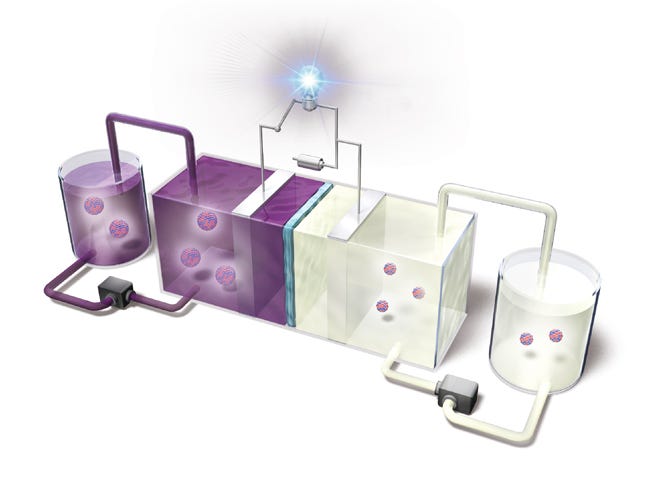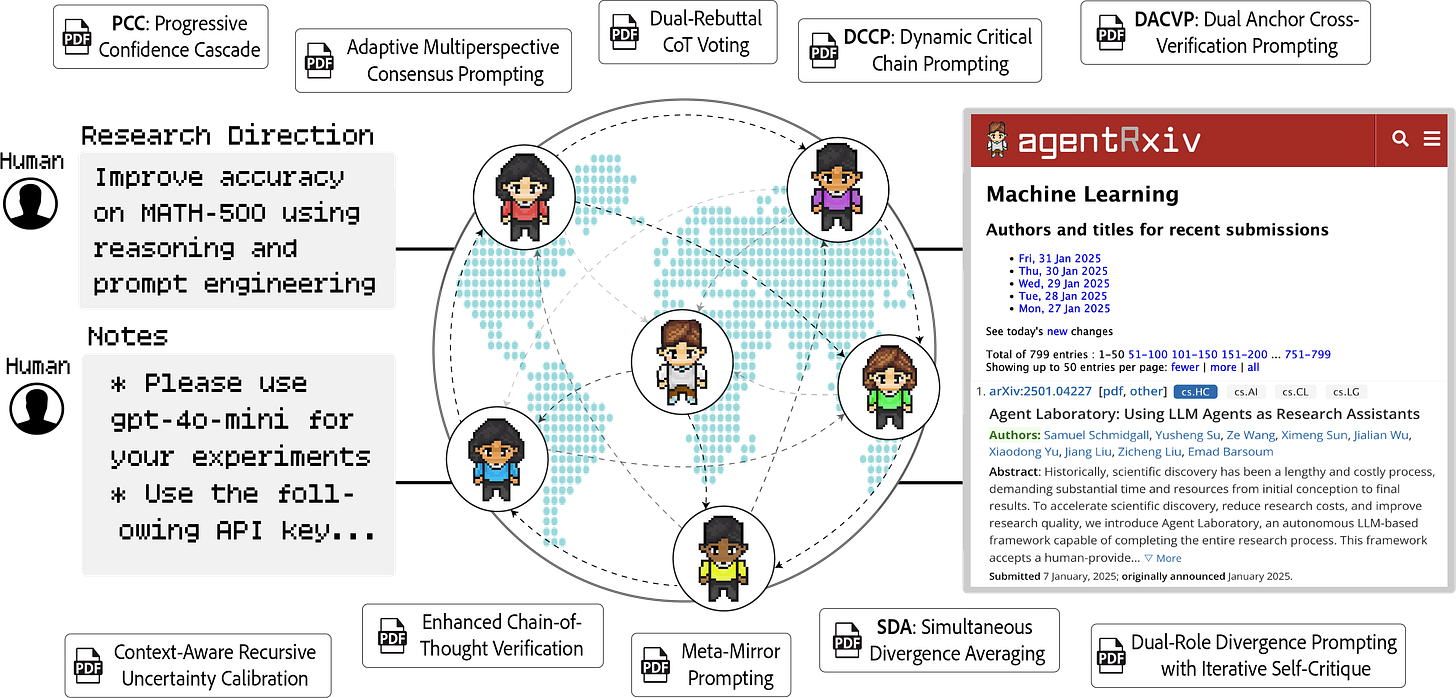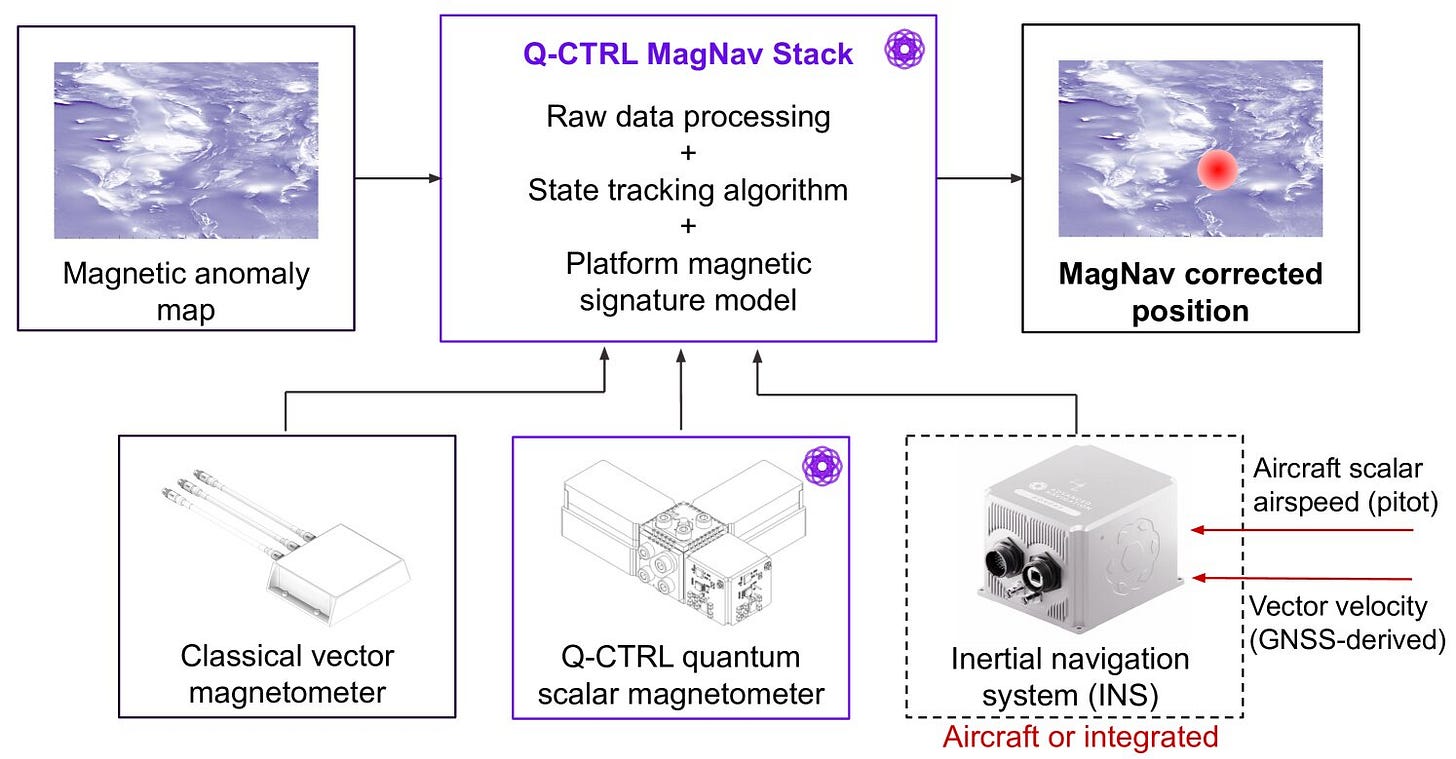Deep Tech Dispatch | #13
Uranium batteries | Non-invasive BCI | Thermodynamics-defying material | Autonomous research | Quantum-based navigation | AI augmentation and much more
🙋🏻♂️ Introduction
Hello friends. I’m introducing a new section for Deep Tech Dispatch called Technology Frontiers where I’ll cover progress happening outside research and University settings. I’ve already done this before under Science & Research News, but given that I’m in the business of venture, a dedicated section feels more appropriate. Also, adding in table of contents:
☢️ Uranium batteries for grid storage
🧠 Invisible brain-computer interface
🧙♂️ Thermodynamics-defying materials
🤖 Towards collaborative autonomous research
📍 Beating GPS accuracy with quantum sensing
🎥 Ambient recording - the human augmentation thesis
💡 Does AI augmentation help low-skilled or high-skilled workers?
📉 How geopolitics can kill companies
✈️ Commercial airplanes will be soon made out of plastics
Reading time: 10 minutes.
🧑🏻🔬 Science & Research News
Uranium batteries for grid storage
Researchers from the Japan Atomic Energy Agency (JAEA) have created a rechargeable battery running on depleted uranium, which could be used in the future to make use of nuclear waste as grid storage for renewables like solar and wind. Specifically, they’ve created a prototype of a flow battery that uses uranium at the electrode and iron at the cathode. If you don’t know how a flow battery works: A flow battery is a rechargeable battery that stores energy in liquid chemical solutions held in external tanks, circulating them through a central cell to convert chemical energy into electricity and vice versa. This makes them a bit bulkier, but very robust and easy to scale. The current version is only at lab scale, achieving a voltage of 1.3V - close to the common 1.5V alkaline battery - enabling it to power an LED. For a scaled-up version of the technology, the JAEA researchers want to deploy 650 tonnes of uranium that has a capacity of 30kWh, potentially supplying 3,000 homes. And with proper shielding, the radioactive uranium should not be a health hazard. You can find the article here and the press release here.
The invisible brain-computer interface
Researchers from Georgia Tech have created a tiny, non-invasive brain-computer interface (BCI) that can fit between strains of hair. BCIs use EEG sensors to record and decode electrical signals from the brain. Normally though, these devices (if non-invasive) are super clunky, employing rigid sensors that stop working properly in real-life conditions, as they move around and lose contact. This BCI is made of microneedle electrodes that can penetrate the skin (nearly) pain-free. The electrical signals captured from the microneedles are then forwarded to a miniaturised circuit on the back of the neck of the user that transmits signals to external systems like AR glasses for proper processing. To evaluate the BCI, researchers tested which stimulus the subject was looking at, with a classification accuracy of 99.2%, 97.5% and 92.5%, while standing, walking and running, respectively.
“This BCI system can find wide applications. For example, we can realize a text spelling interface for people who can’t speak,” says W Hong Yeo, Harris Saunders Jr Professor at Georgia Tech and director of the WISH Center, who co-led the project with Tae June Kang from Inha University in Korea. “For people who have movement issues, this BCI system can offer connectivity with human augmentation devices, a wearable exoskeleton, for example. Then, using their brain signals, we can detect the user’s intentions to control the wearable system.”
You can find the paper here and the article here.


Thermodynamics-defying material
Researchers from University of Chicago have discovered a seemingly thermodynamics-defying material that reacts in their stable state to heat, pressure and electricity like other materials, but flips their reactions once put in a metastable state. In this metastable state, the material expands when compressed and shrinks when heated. To understand what a metastable state is think of a ball on a hill. The ball is unstable at the top and will roll down to the stable state at the bottom. If there is now a dent on the way down, the ball might stay in that dent, reflecting the metastable state. Diamonds for example are metastable versions of graphite. To get back to the material itself, the applications of these flipped reactions are manifold: they can be used as construction materials negating thermal expansion effects or be implemented in batteries for electric airplanes that struggle with changes in temperature and pressure at different altitudes. These are only few immediate ideas from the researchers, but there are endless possibilities for materials that can resist heat or pressure. There is also the potential to create new batteries with these metastable materials, where pushing them into their metastable state could restore their capacity.
“You don’t have to send the battery back to the manufacturer or to any vendors. You just do this voltage activation,” Zhang said. “Then, your car will be a new car. Your battery will be a new battery.”
You can find the paper here and the article here.
Towards collaborative autonomous research
Researchers from John Hopkins and ETH Zurich have developed the Agent Laboratory framework AgentRxiv. It enables autonomous research labs and agents to share, store, organise and retrieve research generated by each other, mirroring the collaborative nature of human science. Research usually isn’t the result of a single “Eureka” moment, but a combination of different researchers and ideas collaborating in a complex manner over time. By drawing inspiration from collaborative platforms like arXiv, the team has designed a centralised framework that allows autonomous acting research agents and labs to collaborate and build on each others discoveries, potentially improving autonomous research performance and interdisciplinary knowledge transfer by connecting agents across ecosystems. As soon as agent-generated research is published, other agents have access to that research and can find it through targeted similarity search. This is a big step towards continuously operating autonomous research systems that overcome the current sequential workflows like Google’s AI scientist. You can find the paper here and the repo here.
🔬 Technology Frontiers
Beating GPS accuracy with quantum sensing
Q-CTRL, a quantum company based in Australia, has successfully field-tested a new quantum-based navigation system, resilient to jamming and denial, that outperforms GPS by a factor of 50 regarding positioning accuracy. The system itself deploys highly sensitive quantum sensors to detect subtle magnetic signals from Earth’s structure, which act as landmarks for accurate positioning - all without relying on external GPS signals. This makes this positioning and navigation system completely passive, undetectable and immune to (targeted) disturbance. With that, it solves one of the most pressing navigation challenges in sectors ranging from defense, to transport and autonomous systems. The system is also small enough to fit on small fixed-wing drones or autonomous cars, and powerful enough to enable navigation in passenger airliners. Q-CTRL already started commercialising this technology with defence departments from Australia, the UK and the US, as well as for commercial aviation with Airbus. You can find the paper here and the press release here.
“We achieved an accuracy in some trials comparable to a sharpshooter hitting a bullseye from 1,000 yards away,” said Q-CTRL CEO and Founder Michael J. Biercuk. “But because our quantum-assured navigation system allows a vehicle to position itself accurately irrespective of how far it’s travelled, by analogy that sharpshooter can hit the same bullseye no matter how far away they move from the target.”
💡 Articles & Ideas
Ambient recording - the human augmentation thesis
Sharing a cool thesis on AI augmentation from Alex Reinhart at Pillar VC. She ultimately envision a future where seamless audio (and eventually visual) recording become common place that can passively capture interactions to improve memory but also productivity. The people reading this using things like Granola for recording will see the benefit. You can basically create a database that contains all of your interactions to improve your productivity. Sounds weird at first (“How would you react if I was recording you right now?”), but I can see and support the big vision of augmentation. Ultimately, these feels simply like another controversial technology that will become common place in the not so distant future - just like calculators back in the day. She gives some good suggestions and predictions how multiple factors need to line up, from wearable device developments, to frameworks for data storage and processing, as well as regulation. Give it a read!
Does AI augmentation help low-skilled or high-skilled workers?
Speaking of AI augmentation, whom benefits it the most? Low-skilled workers that can up-skill their knowledge with commodity intelligence, or are high-skilled workers that can leverage AI improve their skillset and pace further? Or to phrase it differently, will AI compress or widen skill distribution? Noah Smith discussed a few academic papers researching this question in his newsletter (part 6). The research consensus was the former for quite some time (enhancing low-skilled workers), but there is now new research popping up, nudging into the opposite direction. One research paper shows, that AI boosts top researchers a lot more than mediocre ones and another one shows a similar relationship in entrepreneurship, further enhancing already top performing entrepreneurs. But the main factor governing these relationships seem to be the current limitations of AI. Top researchers simply automate easy tasks and focus on the complex ones - where the opposite is impossible for the average researcher - while the less gifted entrepreneurs ask AI hard questions it is not good enough to handle. With increasing AI performance, the gap should get smaller and AI augmentation should have equal effects across skill level.
How geopolitics can kill companies
Another cool article I wanted to highlight from Construction Physics. Bedrock Materials, a sodium battery startup shut down operations recently. But not because they were out of cash - they had millions in the bank and made strong progress on their technology development, even better than expected - but because they simply were unable to compete against dropping lithium battery prices. Since they started out building their technology, lithium prices crashed 85% because of oversupply and worldwide slowing demand, totally destroying their cost competitiveness. The whole reason why they wanted to compete against lithium batteries in the first place were the horrendous resource prices - like so many alternative battery chemistry designs. With lithium being supply constrained and sodium an abundant resource, the initial journey made a lot of sense. But this reasoning is no longer reflected in reality. Now more than ever, technologies will rise and die because of geopolitical implications and volatility.
🤔 Odd Read of the Week
Commercial airplanes will soon be made of plastic
Apparently, commercial airliners will be soon be mass produced with plastics. Say good bye to aluminium based fuselages. Because of the anticipated high outputs by Boeing and Airbus for their new narrow-body jets (single aisle aircraft), they need new ways of mass producing their planes. Thermoplastics seem to be a great way of achieving this, as they can be reshaped and welded, making automation quite simple compared to riveting of aluminum parts or autoclave curing for carbonfiber composites.
Airbus R&D executive Axel Flaig noted: “If you want to build an aircraft a day, you need a different way of doing things.”
Thermoplastics could be that way. According to engineers, this material enables “ultrasonic welding” and reshaping without lengthy curing, making it ideal for future high-rate production lines.
You can find the press release here.
📚 Further Goodreads
What most agent startups are currently building is not agents, it's workflows, that is "systems where LLMs and tools are orchestrated through predefined code paths." Workflows may still bring some value, especially for vertical adaptations. Yet, to anyone currently working in the big labs it's strikingly obvious that all major progress in autonomous systems will be through redesigning the models in the first place.
The advantages and challenges of nuclear-powered data centers
First-of-a-kind reactor deployments are expensive. Initial deployments of nuclear power plants “can carry a high price tag, posing a potential barrier to nuclear energy ramping up to power the data center revolution.” However, the modular construction of advanced reactors is expected to reduce construction and scheduling costs.
Aiming for Lighter Light Sails
To explore the Universe beyond our Solar System on a reasonable time frame, scientists need spacecraft that can move faster than those that currently exist. One route to faster spacecraft involves powering them by light sails—ultrathin, reflective structures that use laser-driven radiation pressure to propel them to high speeds.
The race to secure subsea cables
There is also a growing concern around hyperscalers […] making significant investments in building their own subsea cable infrastructure, hence going from being customers to owners, which increases nation-states’ dependencies on these corporations to secure critical infrastructure.
Can European space industry compete with American domination?
We are witnessing the emergence of “Newspace” in Europe. Start-ups that are mainly privately funded and exploit new development methods are therefore more flexible than the longer-standing players. There are now several hundred start-ups established in Europe, but, again segmented for different activities: launch, observation and connectivity. Since these start-ups have only been created in the last few years, they do not yet have the critical mass needed to face American competition.
Frontier AI Models Still Fail at Basic Physical Tasks: A Manufacturing Case Study
Dario Amodei, CEO of Anthropic, recently worried about a world where only 30% of jobs become automated, leading to class tensions between the automated and non-automated. Instead, he predicts that nearly all jobs will be automated simultaneously, putting everyone “in the same boat.” However, based on my experience spanning AI research […], robotics, and hands-on manufacturing […], I see a different near-term future.
Fundamental Development Gap Map 1.0
This is a new web portal by the team at Convergent Research that we built out with the help of scientists and researchers in our ecosystem to explore the landscape of R&D gaps holding back science and the bridge-scale fundamental development efforts that might allow humanity to solve them.
MEMS Clocks: Saving Power for AI
For AI, clocks not only need to be more precise, but also synchronized perfectly across many GPUs. Large AI models split their tasks among many GPUs, with each one doing a small chunk of the calculation. Then, their results are stitched back together. If one GPU lags behind the others, the whole calculation will have to wait for that node. In other words, the computation is only as fast as the weakest link. All of the GPUs remain turned on while they wait, so any such delay results in energy losses.
The State of Photonic Computing 2025
The absence of practical optical memory represents the single most significant barrier to viable all-optical computing. While electronic memory has benefited from decades of refinement and manufacturing scale, optical memory remains largely theoretical or confined to laboratory demonstrations.
Transformers and genome language models
Large language models based on the transformer deep learning architecture have revolutionized natural language processing. Motivated by the analogy between human language and the genome’s biological code, researchers have begun to develop genome language models (gLMs) based on transformers and related architectures. This Review explores the use of transformers and language models in genomics
Why Can't Physicists Decide if Warp Drives are Real?
It's not that we can't make up our minds, but it's that these calculations sit at the very edge of our knowledge and abilities. And if I'm being honest, beyond them. So things are going to shift around quite a bit, and the truth is that we don't have a firm answer. For example, one set of calculations suggests that quantum fields living at the edge of the warp drive bubble essentially blow up to infinity as soon as you turn the thing on, which would be bad. Very bad.
Future Chips Will Be Hotter Than Ever
Imec foresees several backside technologies that may allow chips to operate at lower voltages, decreasing the amount of heat they generate. The first technology on the road map is the so-called backside power-delivery network (BSPDN), which does precisely what it sounds like: It moves power lines from the front of a chip to the back. All the advanced CMOS foundries plan to offer BSPDNs by the end of 2026.
The growing memristor industry
The memristor industry is growing quickly, raising abundant capital investment, creating new jobs and placing advanced products in the market. Here we analyse the status and prospects of the memristor industry, focusing on memristor-based products that are already commercially available, prototypes with a high technological readiness level that might affect the market in the near future, and discuss obstacles and pathways to their implementation.







